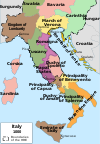You can help expand this article with text translated from the corresponding article in Italian. (February 2023) Click for important translation instructions.
|
| Vitiges | |
|---|---|
| King of the Ostrogoths | |
 Quarter Siliqua of Witigis. Quarter Siliqua of Witigis. | |
| Reign | 536 – 540 |
| Predecessor | Theodahad |
| Successor | Ildibad |
| Born | ≥500 |
| Died | 542 |
| Spouse | Matasuntha |

Vitiges (also known as Vitigis, Vitigo, Witiges or Wittigis, and in Old Norse as Vigo) (died 542) was king of Ostrogothic Italy from 536 to 540. He succeeded to the throne of Italy in the early stages of the Gothic War of 535–554, as Belisarius had quickly captured Sicily the previous year and was in southern Italy at the head of the forces of Justinian I, the Eastern Roman Emperor.
Vitiges was the husband of Queen Amalasuntha's only surviving child, Matasuntha; therefore, his royal legitimacy was based on this marriage. The panegyric upon the wedding in 536 was delivered by Cassiodorus, the praetorian prefect, and survives, a traditionally Roman form of rhetoric that set the Gothic dynasty in a flatteringly Roman light. Soon after he was made king, Vitiges had his predecessor Theodahad murdered. Theodahad had enraged the Goths because he failed to send any assistance to Naples when it was besieged by the Byzantines, led by Belisarius.
Belisarius took both Vitiges and Matasuntha captive to Constantinople, and Vitiges died there in 542, without any children. Procopius described parallels among the deposition of Vitiges and Croesus, king of Lydia. After his death, Matasuntha married the patrician Germanus Justinus, a cousin of Justinian I through his uncle Justin I.
Legend
Witige (in Norse Viðga) is one of the heroes of epic literature that flourished around the figure of Dietrich von Bern (Theodoric of Verona). Witige is the son of the mythical blacksmith Wieland and at the age of twelve, he leaves his father's house to seek adventure. Arriving in Bern (Verona), he challenges the young prince Dietrich to a duel and defeats him thanks to the sword given to him by his father, Mimminc. Dietrich and Witege make a pact of brotherhood. Among the heroes in Dietrich's service are the old Hildebrand and the brave Heime. The Hun king Etzel asks Dietrich for help in a military campaign against the Swedish king Ósantrix. During the battle, Witege is captured and Vildifer, his faithful friend, concocts a ruse to free him: Vildifer disguises himself as a bear and infiltrates the court of Ósantrix in the guise of a dancing bear following a minstrel. In this way, he discovers where Witege is being held prisoner, attacks King Ósantrix, kills him, and frees his friend.
Following the episode, a quarrel between Witege and Heime over the ownership of the sword Mimminc, which the latter had taken after the former had been captured and left for dead. Witege gets his sword back and the two swear friendship. To win the hand of the beautiful Bolfrina, Witege leaves Dietrich's court and swears allegiance to King Ermrich, Dietrich's uncle. When Ermrich declares war on his nephew, Witege is forced to side with Ermrich: Dietrich flees before the enemy army and takes refuge at the court of Etzel, king of the Huns. After several years, Dietrich, thanks to Etzel's support, organizes a campaign to reconquer his kingdom. Dietrich still trusts in Witege's friendship, but, he continues faithful to Ermrich. During a duel, Witege is forced to kill Orte and Scharphe, Etzel's sons, and Diether, Dietrich's brother, all three still children. Dietrich is furious and sets out in pursuit of Witege, who to save himself throws himself into the sea, where the mermaid Wachilde, his ancestor, welcomes him.
Transported by the mermaid to Zealand, Witege lives for many years on a deserted island giving specific orders to the ferryman not to allow Dietrich there, of whom he provides a statue. Dietrich, however, finds Witege's hiding place and, wanting to avenge his brother Diether at all costs, has one of his eyes removed so as not to be recognized by the ferryman. Having reached Witege's home, Dietrich steals the hero's sword Mimminc, then challenges him to a duel. Witege, deprived of his best weapon, is overwhelmed and dies, but not before inflicting deep wounds on his opponent. Dietrich, after throwing Mimminc into a lake, dies from the wounds inflicted on him by Witege.
In fiction
Vitiges appears as a character in the time travel novel Lest Darkness Fall, by L. Sprague de Camp. He is portrayed by Florin Piersic in the 1968 film Kampf um Rom.
See also
References
- Edward Gibbon; Henry Hart Milman (1880). The History of the Decline and Fall of the Roman Empire. Harper & brothers. p. 271.
- Julius von Pflugk-Harttung; John Henry Wright (1905). The great migrations. Lea brothers & company. p. 374.
- ^ Kovács, Tamás (2019). "Procopius's Sibyl – The Fall of Vitigis and the Ostrogoths" (PDF). Graeco-Latina Brunensia. 24 (2): 113–124. doi:10.5817/GLB2019-2-8.
- John H. Rosser (2012). Historical Dictionary of Byzantium. Scarecrow Press. p. 458. ISBN 978-0-8108-7567-8.
- John Stevens Cabot Abbott; Wilfred C. Lay (1900). Italy. P. F. Collier. p. 424.
- John R. Martindale (1980). The Prosopography of the Later Roman Empire: Volume II, AD 395–527. Cambridge University Press. p. 505. ISBN 0-521-20159-4.
- The saga of Thidrek of Bern, translated by Edward R. Hayes, New York, Garland, 1988.
- Von der Hagen's, summary of Thidrekssaga chapters 1-79, chapter-numbering of the Membrame-manuscript, consistency of the saga by Boer; C. Boer, Ueber die Handschriften und Redactionen der Thidrekssaga, in: Arkiv foer nordisk filolog
| Regnal titles | ||
|---|---|---|
| Preceded byTheodahad | King of the Ostrogoths 536–540 |
Succeeded byIldibad |
This Italian history article is a stub. You can help Misplaced Pages by expanding it. |
